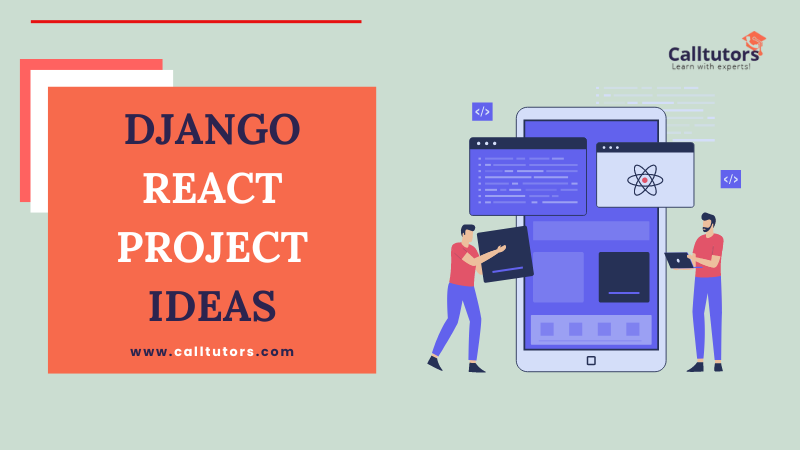For web development, mastering modern frameworks is essential. Django react project ideas are two of the most popular tools for backend and frontend development, respectively. Combining them can lead to powerful and efficient web applications.
This guide will provide you with an in-depth understanding of Django and React, along with project ideas to enhance your web development skills.
Brief Introduction to Django and React
Table of Contents
Django is a high-level Python web framework that encourages rapid development and clean, pragmatic design. It’s known for its robust feature set, which includes an ORM, authentication mechanisms, and a templating engine, among others.
React, on the other hand, is a JavaScript library developed by Facebook for building user interfaces, especially single-page applications where you need a fast, interactive user experience. It allows developers to create large web applications that can update and render efficiently in response to data changes.
Importance of Working on Django react project ideas
Here are the importance of django react project ideas”
to Enhance Web Development Skills
Hands-on projects are crucial for mastering web development. They help reinforce theoretical knowledge and develop problem-solving skills. By working on real-world projects, you encounter challenges that require you to think critically and apply what you’ve learned in practical scenarios.
Why Choose Django React Project Ideas?
Django and React complement each other well. Django’s strengths in handling backend operations, coupled with React’s capabilities in creating dynamic user interfaces, make for a powerful combination.
Benefits of Using Django for Backend Development
- Speed and Efficiency: Django’s built-in features, such as its ORM and admin interface, enable rapid development.
- Security: Django provides robust security features, including protection against SQL injection, cross-site scripting, and cross-site request forgery.
- Scalability: Django is designed to help developers scale applications. It can handle high traffic volumes and large datasets efficiently.
Advantages of React for Frontend Development
- Component-Based Architecture: React promotes reusability through its component-based architecture, making code more manageable and easier to debug.
- Virtual DOM: React’s use of the virtual DOM improves performance by minimizing direct manipulation of the actual DOM.
- Strong Community and Ecosystem: React has a large community and a rich ecosystem of libraries and tools, which accelerates development and problem-solving.
How Combining Django and React Can Lead to Powerful Web Applications
Combining Django and React allows developers to leverage the strengths of both frameworks. Django handles the server-side logic and database interactions, while React manages the client-side rendering and user interactions. This separation of concerns results in a more modular and maintainable codebase.
Getting Started with Django React Project Ideas
Here are the best Django React project ideas for students:
Setting Up Your Development Environment
To begin developing with Django and React, you’ll need to set up a development environment. Here’s a quick guide:
- Install Python: Ensure you have Python installed. Django is a Python framework, so this is essential.
- Install Node.js and npm: React requires Node.js and npm (Node Package Manager) for managing dependencies.
- Set Up a Virtual Environment: Use virtualenv to create isolated Python environments.
- Install Django: Use pip to install Django in your virtual environment.
- Install Create-React-App: Use npm to install the Create-React-App tool, which sets up a new React project with sensible defaults.
30+ Django React Project Ideas For Students
The following are the great Django react project ideas for students:
Beginner-Level Django React Project Ideas
- Simple To-Do List App: A basic app to manage daily tasks.
- Personal Blog with Markdown Support: A blog platform that supports markdown for formatting posts.
- Basic E-commerce Store: An online store with product listings, a shopping cart, and checkout functionality.
Intermediate-Level Django React Project Ideas
- Real-Time Chat Application: A chat application that supports real-time messaging.
- Recipe Sharing Platform: A platform for users to share and discover recipes.
- Task Management System: A system for managing and tracking tasks and projects.
Advanced-Level Django React Project Ideas
- Social Media Platform: A full-fledged social media platform with user profiles, posts, and interactions.
- Online Learning Management System: A system for managing online courses, including video lectures, quizzes, and assignments.
- Comprehensive CRM System: A customer relationship management system with features for managing contacts, sales, and customer interactions.
In-Depth Look at a To-Do List App
A To-Do List App is a great starting point for learning Django and React. It involves creating a simple interface for users to add, delete, and mark tasks as complete.
Detailed Steps to Build the Backend with Django
- Create a New Django Project: Use
django-admin startproject todo_project. - Set Up the Database: Configure the database settings in
settings.py. - Create a Todo App: Use
python manage.py startapp todoto create a new app. - Define Models: Create a
Taskmodel with fields for task name, description, and status. - Migrate Models: Use
python manage.py makemigrationsandpython manage.py migrateto create the database schema. - Create Views and Serializers: Define API endpoints for creating, reading, updating, and deleting tasks.
- Set Up URLs: Map the URLs to the corresponding views.
Detailed Steps to Build the Frontend with React
- Create a New React Project: Use
npx create-react-app todo-frontend. - Set Up State Management: Use React’s
useStateanduseEffecthooks to manage state and side effects. - Create Components: Create components for displaying the task list, adding new tasks, and editing existing tasks.
- Connect to the Backend: Use
axiosorfetchto make HTTP requests to the Django API. - Handle User Inputs: Implement form handling for adding and editing tasks.
Integrating the Frontend and Backend
- CORS Configuration: Ensure CORS is configured correctly in Django to allow requests from the React frontend.
- API Endpoints: Ensure the API endpoints in Django match the endpoints used in the React frontend.
- Testing: Test the application thoroughly to ensure the frontend and backend work together seamlessly.
Adding Additional Features and Improvements
- User Authentication: Add user authentication to allow users to create and manage their own tasks.
- Task Prioritization: Allow users to set priorities for tasks.
- Due Dates: Add functionality to set and track due dates for tasks.
Building a Real-Time Chat Application
Setting Up Django Channels for WebSockets
- Install Django Channels: Use
pip install channels. - Configure Channels: Update
settings.pyto include Channels. - Define Routing: Set up routing for WebSocket connections.
- Create Consumers: Define consumer classes to handle WebSocket events.
Creating the Frontend with React
- Set Up WebSocket Connections: Use the
WebSocketAPI or libraries likesocket.ioto manage WebSocket connections in React. - Create Components: Build components for the chat interface, including message input and display areas.
- Handle Real-Time Updates: Implement functionality to handle real-time updates from the WebSocket connection.
Implementing Real-Time Messaging Features
- Broadcast Messages: Ensure messages are broadcast to all connected users.
- Display Messages: Update the UI to display incoming messages in real-time.
- Notification System: Implement a notification system to alert users of new messages.
Handling User Authentication and Authorization
- User Login: Implement login functionality to authenticate users.
- Message Privacy: Ensure messages are only visible to authorized users.
- User Presence: Display user presence (online/offline status).
Tips and Best Practices for Developing Django React Applications
Code Organization and Structure
- Modular Code: Organize code into modules for better maintainability.
- Reusable Components: Create reusable React components to avoid code duplication.
- Clear Separation of Concerns: Keep the backend and frontend concerns separate.
Efficient State Management in React
- Use Context API or Redux: For managing global state.
- Optimize Component Rendering: Use React’s memoization techniques to optimize rendering.
Security Considerations
- Input Validation: Validate and sanitize user inputs to prevent security vulnerabilities.
- Authentication and Authorization: Implement robust authentication and authorization mechanisms.
- Secure Communication: Use HTTPS for secure communication between frontend and backend.
Performance Optimization
- Lazy Loading: Implement lazy loading for components and resources.
- Caching: Use caching mechanisms to reduce server load.
- Code Splitting: Use code splitting to improve load times.
Final Thoughts and Encouragement
Combining Django React Project Ideas allows developers to build robust and dynamic web applications. By working on various projects, you not only improve your technical skills but also gain practical experience that is invaluable in the real world.
Recap of the Benefits of Building Django and React Projects
- Enhanced Skillset: Working with Django and React improves both your backend and frontend development skills.
- Real-World Applications: You gain experience in building applications that solve real-world problems.
- Career Opportunities: Mastery of these frameworks can open up numerous career opportunities in web development.
Encouragement to Start Building and Learning
Start with simple projects and gradually move to more complex ones. The more you build, the more you learn. Don’t be afraid to make mistakes—they are part of the learning process.
Additional Resources and Further Reading
- Official Documentation: Refer to the official documentation for Django and React for in-depth information.
- Online Courses: Platforms like Coursera, Udemy, and freeCodeCamp offer comprehensive courses on Django and React.
- Community Forums: Join community forums and discussion groups to seek help and share knowledge.
By diving into Django and React projects, you set yourself on a path of continuous learning and improvement.



